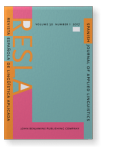Vol. 30:1 (2017) ► pp.273–298
Vol. 30:1 (2017) ► pp.273–298
Estudio longitudinal del desarrollo del acento en español como primera lengua
El presente trabajo propone un análisis de la adquisición del acento basado en el desarrollo de la estructura prosódica del español durante los primeros meses del desarrollo lingüístico. Hay muy poca investigación sobre la adquisición del acento y el desarrollo de la estructura prosódica en esta lengua. Un repaso de la bibliografía sobre adquisición muestra dos hipótesis de trabajo: un sesgo hacia el troqueo, que interpreta que las primeras emisiones infantiles se realizan bajo una forma trocaica por defecto, y una hipótesis neutra, determinada por la estructura correspondiente de la lengua meta. Dado que no hay consenso sobre la adquisición del acento en español, se presenta este trabajo con el propósito de profundizar en el desarrollo del acento en español como primera lengua. Para ello se han analizado las producciones de dos niños monolingües hablantes de español (desde 1;7 a 2;3 años), más los datos adicionales de otro niño a 1;10 años. El estudio no ha proporcionado datos convincentes para apoyar la hipótesis trocaica en el desarrollo del acento en español; sin embargo, los niños que adquieren español dominan los patrones acentuales de esta lengua desde el principio de sus emisiones.
Article outline
- 1.Introducción
- 2.Marco teórico
- 2.1La adquisición del acento
- 2.2La adquisición de la estructura prosódica
- 2.3Estructura silábica y acentual en español
- 3.Metodología
- 3.1Diseño y recogida del corpus
- 3.2Metodología de análisis de los datos
- 3.2.1Criterios específicos de análisis de los datos
- 4.Análisis y resultados
- 4.1Bisílabos (troqueos y yambos)
- 4.1.1Monosílabos
- 4.2Trisílabos (anfíbracos y anapestos)
- 4.3Cuatrisílabos (wwSw)
- 4.4Producción de sílabas y acento. Visión de conjunto
- 4.1Bisílabos (troqueos y yambos)
- 5.Discusión
- 6.Conclusiones
- Notas
-
Referencias
This article is currently available as a sample article.
Article language: Spanish
